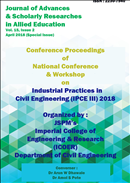Review report on Self-Healing Concrete
Biochemical Method for Crack Repair in Concrete
Keywords:
Self-Healing Concrete, compression, tensile strength, cracks, strength and durability, seepage, corrosion, repair, bacteria, calcium carbonate crystalsAbstract
The most common material used in construction to withstand compression is concrete, but cracks are certain to occur due to the low tensile strength of concrete which results in reduction in strength and durability of a structure. These cracks allow seepage of water as well as other chemicals in the atmosphere which leads to corrosion of reinforcement bars. The repair these cracks is a tedious job and in turn is expensive so to avoid these a special bacteria is induced in concrete which reacts with calcium to form calcium carbonate crystals which blocks the cracks formed in the concrete. This biochemical method results in sealing of micro cracks of size up to 0.15mm we expect to find better results in the near future which will help in sealing even bigger cracks.Published
2018-04-27
How to Cite
[1]
“Review report on Self-Healing Concrete: Biochemical Method for Crack Repair in Concrete”, JASRAE, vol. 15, no. 2, pp. 439–441, Apr. 2018, Accessed: Jul. 17, 2024. [Online]. Available: https://ignited.in/jasrae/article/view/7961
Issue
Section
Articles
How to Cite
[1]
“Review report on Self-Healing Concrete: Biochemical Method for Crack Repair in Concrete”, JASRAE, vol. 15, no. 2, pp. 439–441, Apr. 2018, Accessed: Jul. 17, 2024. [Online]. Available: https://ignited.in/jasrae/article/view/7961








